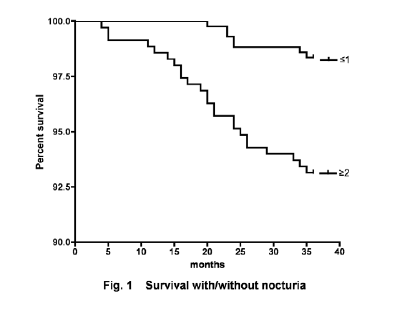Wake Up to Nocturia Studies Reinforce Serious Associated Risk of Nocturia
Barcelona, Spain – 19 April, 2010 –
Study results discussed today at the European Association of Urology (EAU) Congress in Barcelona, have reinforced the association between nocturia and a greater risk of falls and mortality.
In a population-representative study in Japan by Nakagawa et al, it was concluded that adults who suffered from nocturia (defined as two or more episodes of voids/urination per night) had a significantly increased risk of mortality when compared to adults without nocturia, even once adjustments had been made for other contributing factors (e.g. age, gender, physiological conditions).1
Furthermore, a community-based study by Parsons et al in 5,872 men aged 65 years or above, showed that in adults with moderate or severe lower urinary tract symptoms (LUTS), the risk of having at least two falls significantly increased when compared to those with mild LUTS symptoms. Adults who endured 2-3 awakenings per night due to a need for voiding, had a 21% greater risk of at least two falls, while adults who endured 4-5 awakenings due to voids per night had a 63% greater risk.2 Nocturia was among the LUTS most strongly associated with falls.
“These studies have highlighted some vital new insights into nocturia, primarily that it is a serious medical condition that should not be dismissed as a lifestyle matter. The time has come for health providers and the public to give nocturia the attention it deserves,” comments Dr Raymond Rosen from the New England Research Institutes, USA.
Several studies have demonstrated that prevalence of nocturia is high with as many as 20% of adults aged 40-59 years thought to be affected.3,4,5 This increases to approximately 35% in those over 60 years old.3 Nocturia repeatedly disrupts sleep and is associated with multiple negative outcomes including a significant reduction in quality of life and an increased morbidity.6 Interrupted sleep, caused by nocturia, not only affects the patient and their partners but can also affect society through reduced productivity and job performance.7,8,9
“The current lack of awareness about and understanding of nocturia means this major problem often remains undiagnosed or inappropriately treated,” comments Professor Philip Van Kerrebroeck from the University Hospital Maastricht, The Netherlands.
“In many cases, it is wrongly thought to be only a bladder or prostate problem, when nocturia may actually be a kidney problem. We need a two-pronged approach. Physicians need to recognise the signs and symptoms of the condition and treat it appropriately, but patients also need to be aware of the signs so they can go to their doctor as soon as they have any concerns. It is important for patients to understand that their condition can be treated and there is no need for them to suffer in silence”.
Further investigative study will be required to establish whether appropriate treatment of nocturia will help reduce the link between the condition and other chronic diseases.
In an effort to raise awareness of nocturia as a condition in its own right, it has newly been included within the official EAU guidelines. The new chapter on non-neurogenic lower urinary tract symptoms (LUTS), including nocturia, incorporates information on a variety of LUTS treatment options including α-blockers and 5α-reductase inhibitors. The chapter also highlights the role of desmopressin as the only therapy specifically addressing nocturia and its main cause nocturnal polyuria and awards a Level 1 Grade A recommendation.10
– ENDS –
About the studies
Association between nocturia and mortality in a community-dwelling elderly population aged 70 years and over: results of a 3-year prospective cohort study in Japan (Nakagawa et al)
The authors conducted a Comprehensive Geriatric Assessment of all residents aged ≥70 years in 2003 in an urban district of north Japan. The population-based cross-sectional survey was conducted using an extensive health interview for each participant. Mortality over 3 years was investigated using data from the national health insurance system. Differences in survival stratified by presence/absence of nocturia (≥2 voids/night) were assessed with Kaplan-Meier curves, and statistical significance was calculated with the log-rank test. The risk of mortality with or without nocturia was compared using a time varying multivariate Cox proportional hazard model.


Lower urinary tract symptoms increase the risk of falls in older men (Parsons et al)
The authors evaluated 5872 participants in the Osteoporotic Fractures in Men, a prospective cohort study of risk factors for falls and osteoporotic fractures among community-dwelling men aged > or =65 years. The primary outcome was the 1-year cumulative incidence of falls in men with moderate or severe, vs mild LUTS at baseline, as measured by the American Urological Association Symptom Index. They used Poisson regression models and considered multiple variables as potential confounders.
| 2-3 voids/night | 4-5 voids/night | |
| Relative risk of at least one fall |
11% (RR 1.11, 95% CI, 1.01-1.22) |
33% (RR 1.33, CI 1.15-1.53) |
| Relative risk of at least two falls |
21% (RR 1.21, CI, 1.05-1.40) |
63% (RR 1.63, CI, 1.31-2.02) |
For more information, please contact
Natalie Fairbank
Senior Account Executive, Tonic Life Communications
+44 207 798 9999
natalie.fairbank@toniclc.com
Jens-Peter Norgaard
Chief Scientific Officer, Medical Science Urology, Ferring Pharmaceuticals
+45 2878 7547
jenspeter.norgaard@ferring.com
References
- Nakagawa et al. J Urol 2009;181(Suppl):8.
- Parsons et al. BJU Int 2009;104:63-68.
- Irwin DE, Milsom I, Hunskaar S et al. Population-based survey of urinary incontinence, overactive bladder, and other lower urinary tract symptoms in five countries: results of the EPIC study. Eur Urol 2006; 50: 1306-1315.
- Yoshimura K, Terada N, Matsui Y, Terai A, Kinukawa N, Arai Y. Prevalence of and risk factors for nocturia: Analysis of a health screening program. Int J Urol 2004; 11: 282-287.
- Brieger GM, Yip SK, Hin LY, Chung TK. The prevalence of urinary dysfunction in Hong Kong Chinese women. Obstet Gynecol 1996; 88: 1041-1044.
- Asplund R. Nocturia in relation to sleep, somatic diseases and medical treatment in the elderly 5. BJU Int 2002; 90: 533-536.
- Bolge SC, Doan JF, Kannan H, Baran RW. Association of insomnia with quality of life, work productivity, and activity impairment. Qual Life Res 2009; 18: 415-422.
- Bolge SC, Balkrishnan R, Kannan H, Seal B, Drake CL. Burden associated with chronic sleep maintenance insomnia characterized by nighttime awakenings among women with menopausal symptoms. Menopause 2010; 17: 80-86.
- Kobelt G. Health-economic issues in nocturia. BJU Int 1999; 84 Suppl 1: 29-32.
- European Association of Urology Guidelines – 2010 edition.

